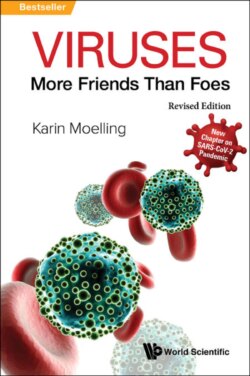Читать книгу Viruses: More Friends Than Foes (Revised Edition) - Karin Moelling - Страница 30
На сайте Литреса книга снята с продажи.
In the beginning were viruses
Оглавление“A beginning must be small and simple.” That seems logical, but it is also just a belief. Bacteria or archaea reach genomic sizes of around one million nucleotides — that is far and away too large for a beginning. This at least is what I think. It must have been smaller, much smaller, more primitive, perhaps a mixture of several molecules, biomolecules in Darwin’s often-cited “warm little pond”. There RNA, as the first biomolecule, may have been the beginning of the tree of life. The discoverers of the giant viruses strongly support the view that giant viruses were on the scene there first, but they may be biased — these viruses are too big for a start. The first RNA is already somehow a naked virus — more exactly, a viroid. This kind of RNA continues to haunt our cells today. (Details will come later.)
Viruses have been around since early on; no pipette in the world and no infection could have caused such a worldwide spread of viruses — they pervade every single living being, without exception. After all, there are about 1.8 million different species known on our planet and about ten times more are unknown, not even including bacteria. There are no exceptions — even though researchers, including myself, keep on looking for them. I have not been able to find a virus-free biological system — or perhaps a single one, the worm C. elegans? It has the strongest antiviral defense! Therefore, it must at least have experienced viruses in the past, because antiviral defense comes from viruses! As you will see… .
What did Darwin think about the origin of life? He was careful, and mentioned in a letter to a friend — the botanist Joseph D. Hooker, Director of Kew Gardens in London — dated 1871: “It is often said that all the conditions for the first production of a living organism are present, which could ever have been present. But if (and oh! what a big if!) we could conceive in some warm little pond, with all sorts of ammonia and phosphoric salts, light, heat, electricity, etc., present, that a protein compound was chemically formed ready to undergo still more complex changes, at the present day such matter would be instantly devoured or absorbed, which would not have been the case before living creatures were formed.” Thus the beginning cannot easily be repeated today. The environmental conditions on the primordial Earth are not known. But Darwin also said that we cannot exclude the possibility that all living creatures on earth have one single origin. As a former physicist, I share this simple thought with enthusiasm.
Recently I published an article with the title: “Are viruses our oldest ancestors?” (EMBO Report 2012). With the question mark at the end, because one cannot really be sure, the article was put into the category “Opinion”. A reader soon sent me an e-mail, pointing out Félix d’Herelle, who together with his colleague John Burdon Sanderson Haldane will be mentioned in more detail later; both published essays, already in the 1920s about viruses as the possible origin of life. At that time d’Herelle had just discovered the phages, the viruses of bacteria. Immediately, the two researchers speculated that viruses, which can self-reproduce, are the “primordial origin” as Darwin called it. I share their vision. However, their contemporaries rejected this idea vehemently.
Every year the New York agent and publicist John Brockman asks leading scientists an annual question, “The Edge”, about the knowledge of tomorrow. “What we believe but cannot prove: Today’s leading thinkers on science in the age of uncertainty” was the question in the year 2005. My answer would have been: Viruses got here first!
This requires a definition of what viruses exactly are.
